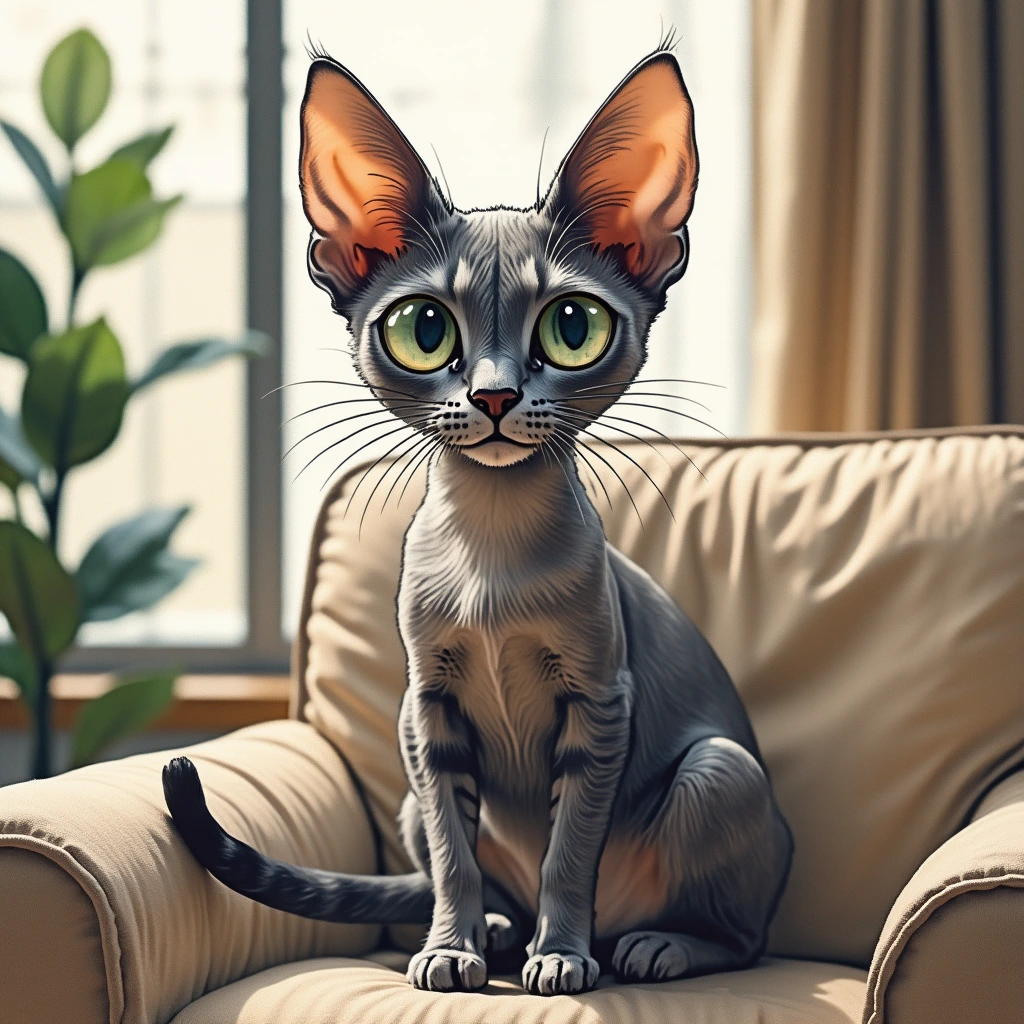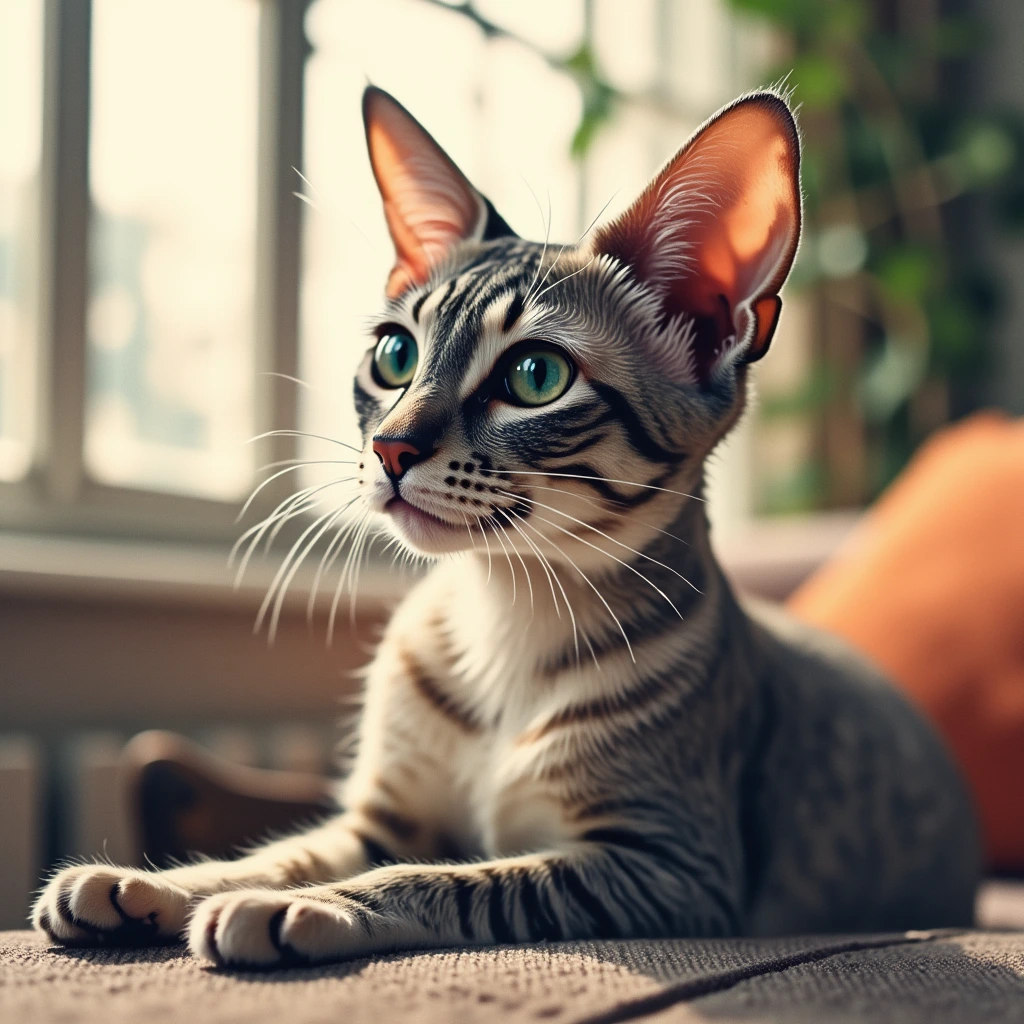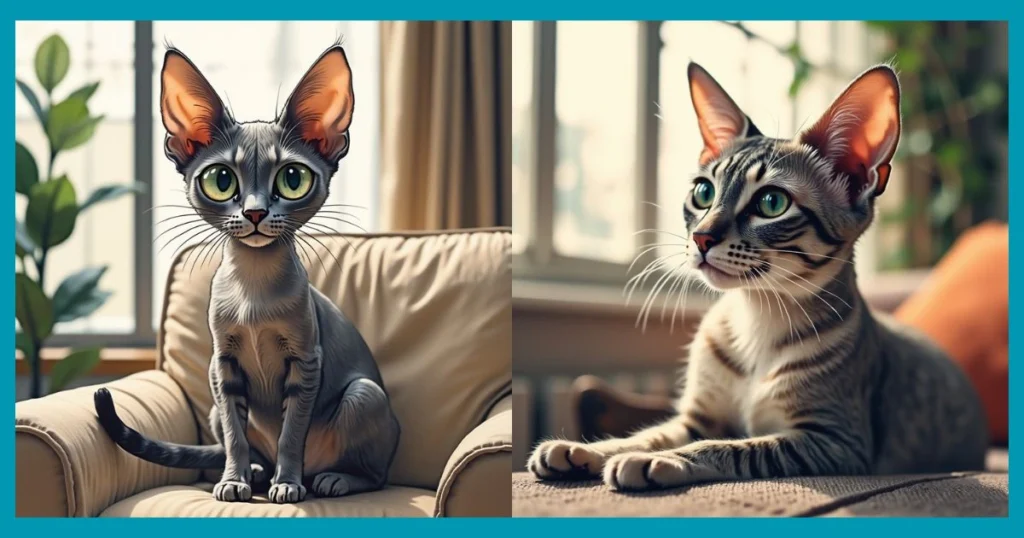House cats with big ears Have you ever noticed how some house cats have especially large, alert ears that seem to be always in tune with their surroundings? These felines aren’t just visually striking—they’re built for superior hearing and heightened awareness. If you’re drawn to cats with big ears, you may find their unique traits and captivating personalities hard to resist. In this guide, you’ll discover why some cats have larger ears, explore the best big-eared cat breeds, and learn how to care for them, ensuring they stay happy and healthy.
Table of Contents
Why Do Some House Cats Have Big Ears?
Ever wonder why some cats are gifted with such prominent ears? These oversized features serve an evolutionary purpose, offering distinct advantages. Cats with big ears evolved with heightened auditory abilities that allowed them to detect the faintest movements, such as the rustle of a mouse in the grass. This exceptional hearing ability helped them hunt and communicate with other cats, giving them a clear advantage in survival.
Big-Eared Cat Breeds

While all cats have great hearing, certain breeds are specifically known for their larger-than-average ears. These breeds have been selectively bred to emphasize those big ears, resulting in some of the most exotic-looking house cats.
- Oriental Shorthair: These slender, sleek cats are well-known for their prominent ears that sit high on their heads. Their ears complement their long, angular faces, giving them a regal, striking appearance.
- Sphynx: This hairless breed is famous not only for its lack of fur but also for its bat-like, oversized ears. Sphynx cats are highly affectionate and social, and their big ears only add to their unique charm.
- Abyssinian: Known for their playful, athletic nature, Abyssinians have large, pointed ears that are always alert. Their ears enhance their sharp, observant expressions, making them look ready for action at any moment.
- Devon Rex: With its curly coat and wide, prominent ears, the Devon Rex is often referred to as an elf-like cat. Their big ears contribute to their mischievous and curious personalities.
Best Breeds of House Cats with Big Ears
If you’re in the market for a house cat with large ears, several breeds stand out for their distinct looks and unique temperaments. Here’s a deeper look into some of the best big-eared breeds:
Oriental Shorthair: The Sleek and Elegant Feline
With its slender body, long legs, and triangular face, the Oriental Shorthair is a breed that exudes elegance. Their ears are enormous in proportion to their heads, making them stand out in any room. These cats are known for their intelligence and curiosity, always exploring their surroundings and often engaging in conversations with their human companions. They require minimal grooming but regular ear care to prevent wax buildup.
Sphynx: The Hairless Wonder with Bat-Like Ears
The Sphynx is one of the most unique cat breeds, primarily due to its hairless body. However, it’s their bat-like ears that catch the most attention. Without fur, their ears stand out even more, giving them an otherworldly appearance. These cats are known for being affectionate lap cats, always seeking warmth and human attention. Due to the lack of fur, regular skin care is a must, as is routine ear cleaning to prevent oil buildup in their ears.
Abyssinian: The Athletic Cat with Large Ears
If you’re looking for a cat with a love for adventure, the Abyssinian is the perfect fit. This breed is incredibly active, always climbing, jumping, and exploring. Their large ears, sitting on top of their muscular heads, help them stay alert to their surroundings. They have a short coat that requires little maintenance, but their ears benefit from regular inspection and cleaning to avoid infections.
Caring for Cats with Big Ears
Owning a cat with big ears comes with its own set of responsibilities. Their large ears require some extra care, but it’s nothing too complicated once you know what to do.
Proper Ear Hygiene house cats with big ears
Big-eared cats tend to collect more dirt and wax than their smaller-eared counterparts, so regular cleaning is essential.
- How to Clean: Use a damp cotton ball or a cloth to gently wipe the outer ear. Avoid inserting anything into the ear canal, as this can cause injury.
- Signs of Trouble: Keep an eye out for any signs of ear infections, such as redness, discharge, or frequent scratching at the ears. If you notice these symptoms, consult your veterinarian for proper treatment.
Health Concerns Specific to Big-Eared Cats
Big-eared cats can sometimes be prone to certain health issues, such as ear mites and infections. These problems are usually preventable with routine care, but it’s important to recognize the symptoms early.
- Ear Mites: These tiny parasites can cause discomfort and itching. If your cat is constantly scratching its ears or shaking its head, a vet visit is in order.
- Infections: Due to the openness of their ear canals, big-eared cats can be more susceptible to infections. Regular cleaning and vet check-ups can help prevent this.
Feeding and Diet for Big-Eared Cats
The diet for a cat with big ears isn’t much different from that of any other house cat, but proper nutrition is essential for their overall health, including their skin and ears.
Nutritional Needs house cats with big ears
A balanced diet consisting of high-quality proteins, fats, and vitamins is crucial. Many cat owners prefer a mix of wet and dry food to ensure their cats get enough hydration and the right nutrients.
Suggested Recipe for Homemade Cat Treats:
Try making this simple recipe that your big-eared feline will love:
| Ingredient | Quantity | Notes |
|---|---|---|
| Chicken breast | 1 lb | Cooked and shredded |
| Mashed carrots | ½ cup | Provides fiber and vitamins |
| Olive oil | 1 tbsp | Helps keep their coat healthy |
These treats are not only delicious but also help with coat and ear health, thanks to the added olive oil.
FAQ Section house cats with big ears

Why Do House Cats Have Big Ears?
Big ears help cats enhance their sense of hearing, allowing them to detect even the smallest noises in their environment.
Are Big-Eared Cats More Prone to Ear Infections?
Yes, their open ear canals can make them more susceptible to infections. Regular cleaning and vet check-ups can help prevent this.
What Breeds of Cats Have the Biggest Ears?
Breeds like the Oriental Shorthair, Sphynx, and Abyssinian are known for their large, distinct ears.
How Often Should I Clean My Big-Eared Cat’s Ears?
It’s recommended to clean your cat’s ears at least once every two weeks to prevent wax buildup and infections.
Conclusion house cats with big ears
House cats with big ears aren’t just captivating in appearance—they’re also uniquely equipped for heightened awareness. Whether you already have a big-eared feline friend or are thinking of adopting one, providing them with the right care is essential. From regular ear cleaning to proper nutrition, your cat will thrive with a little extra attention. So, why not make your home a little more exciting by adding a big-eared companion to your life?
house cats with big ears


